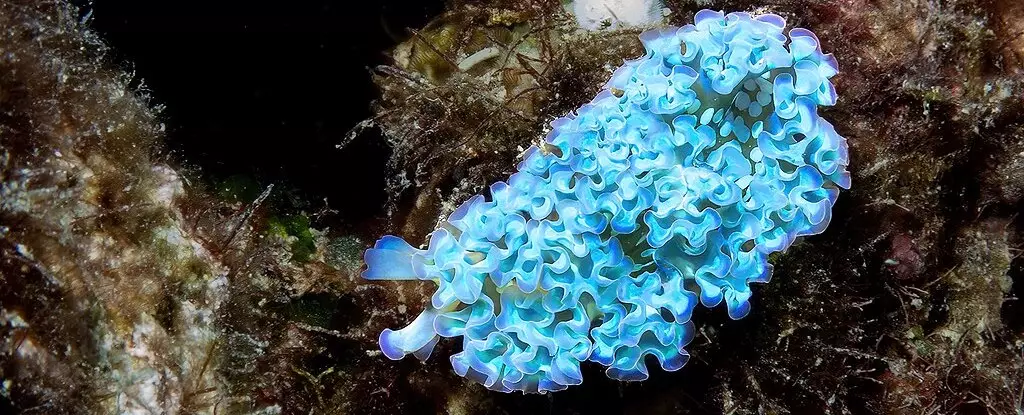In the vast and peculiar world of marine life, the lettuce sea slug (Elysia crispata) stands out as one of the most astonishing examples of evolutionary ingenuity. At first glance, its vibrant green, lettuce-like form could easily be mistaken for something out of a science fiction tale — an alien creature lacking in any semblance to earthly biology. However, the reality is far more intriguing; this slimy taunter of the tides has the remarkable ability to pilfer body parts from other organisms, effectively commandeering their biological tools for its own benefit. In a world rife with competition, the lettuce sea slug emerges not merely as a survivor but as a quintessential eloquence of existential theft.
The concept of an organism stealing traits from others may remind one of some ludicrous plotline from a comic book; yet, this captivating little being thrives through such kleptomania. The sea slug capitalizes on its primary food source—algae—not by consuming it in the traditional sense, but by absorbing its chloroplasts, the very organelles that allow algae to undergo photosynthesis. Imagine being able to absorb the very essence of sunlight, utilizing it as a renewable energy source in a world fueled by scarcity. It turns a simple survival mechanism into a spectacular performance of biological chicanery.
Redefining Photosynthesis
The mechanics of this biological heist are nothing short of revolutionary. Traditionally, chloroplasts are subject to digestion along with the rest of the food. For the lettuce sea slug, however, digestive norms are cast aside. Instead, this creature eloquently captures these life-sustaining organelles and stores them in specialized sacs known as ‘kleptosomes’. Here, they remain alive, thriving in a symbiotic relationship that challenges our conventional understanding of interspecies interaction. It raises profound questions: What does it mean to share a body? Are these kleptosomes merely incubators, or do they facilitate a broader communion of life itself?
Recent studies led by researchers at Harvard University unveil that these kleptosomes do not simply go dormant; they actively engage with the slug’s physiology. Even after being pilfered, the chloroplasts continue generating algal proteins and start mingling with slug proteins. This fascinating dance of molecular collaboration highlights the depth of interdependence within nature, challenging the idea that survival necessitates competition or destruction.
The Complexity of Survival and Adaptation
What does it mean for the ecosystem when these elaborate thefts allow the lettuce sea slug to thrive? In an increasingly resource-scarce world, where environmental degradation is more than a theoretical concern, this creature showcases adaptation in an astonishing manner. It teaches us that survival methods are not always straightforward, and that a collaborative approach — even one that borders on theft — could pave the way for the future. These lessons reveal a vital truth: Nature is not exclusively a brutal arena of the fittest, but rather a tapestry of cooperation, blurring the lines between predator and prey.
However, this intricate web of interactions does not come without consequences. Research indicates that lettuce sea slugs alter their coloration based on their nutritional intake, with well-fed individuals showcasing their vibrant greens, while those that endure hunger dull into shades of orange. This transformation signals a desperate shift — showcasing how reliance on stolen chloroplasts has its limits. It causes one to ponder, what happens when they can no longer supply the energy necessary for survival? Are we destined to face the consequences of our dependencies, no matter how cleverly we manipulate them?
Beyond the Sea: Implications for Evolutionary Biology
The biological wonders of the lettuce sea slug extend further than understanding a peculiar predator-prey dynamic. Investigating this phenomenon offers critical insight into fundamental questions surrounding evolutionary biology. Just as obsolete mitochondria evolved from ancient symbiotic bacteria to become a cornerstone of energy production in our cells, could such kleptoplastic relationships redefine our understanding of evolutionary resilience? There is palpable intrigue here, and perhaps it is a reminder that the boundaries of biology are only as fixed as we believe them to be.
The lettuce sea slug embodies the powerful narrative of adaptation through cunning and collaboration rather than competition. Through its evocative existence, it forces us to confront what we think we know about life, survival, and the astonishing complexity of existence itself. In a time when the interdependencies of all life forms are more threatened than ever, there is a certain profound beauty to be found in a sea slug that personifies thievery, reminding us that even in the act of stealing, life can flourish.



Leave a Reply